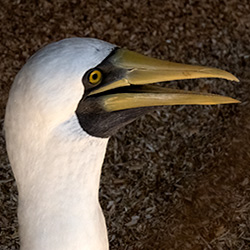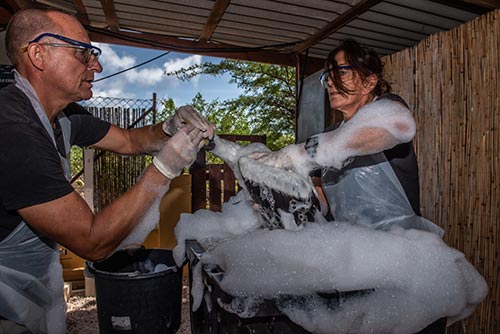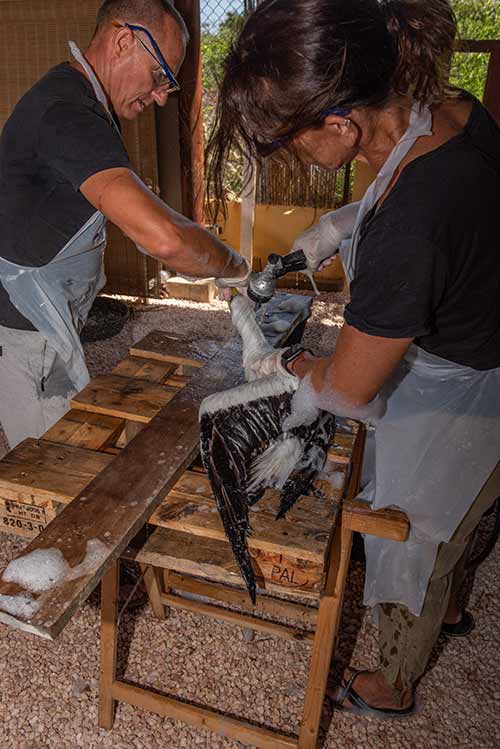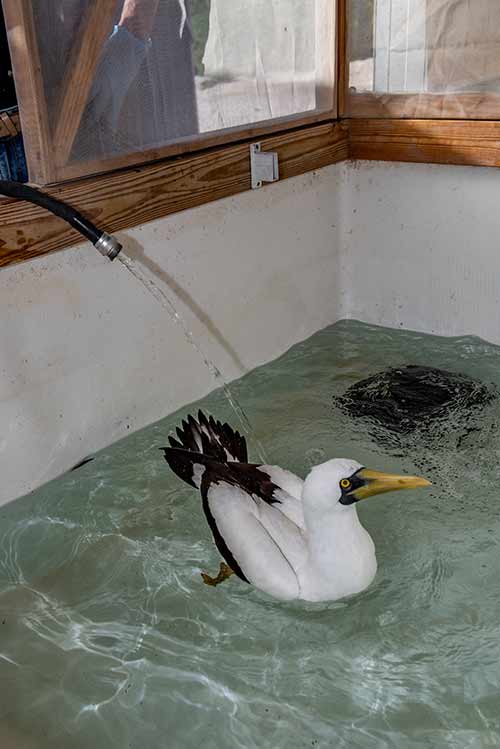A Masked Booby receives some much-needed Tender Loving Care from Bonaire!
The island of Bonaire pitches in when nature calls for help.
Posted December 20, 2021
The Masked Booby’s back-story.
In nearly everyone’s life, there comes a time when we need help and assistance. There are situations that mandate that we put aside our pride and accept some TLC (tender, loving care) from someone else. Sometimes our feathered friends have the same need, and in the recent case of a Masked Booby, the island of Bonaire was able to provide that TLC!
Friday, November 12, 2021.
A cruise ship steamed into the Port of Kralendijk and docked in town. Unknown to immigration officials at that time, a very special stow-away was on board.
For the three days preceding the ship’s arrival on Bonaire, a Masked Booby had precariously clung to the top of the ship never letting go for one moment. It must have known something was wrong, knew it needed assistance, and alighted upon the first “land” it saw–the ship–and then held on for dear life until it found the “first port in a storm”–Bonaire!
The crew knew the bird was stowing away, but couldn’t assist it until the ship was safely docked in port and no longer underway. Once here in the island’s port, the ship’s crew could capture the now weakened Masked Booby. Standing by at the ready were the staff of Bonaire’s Animal Rescue Foundation, who immediately transferred the Masked Booby to the Flamingo Island Veterinary Center. There, the island’s vets checked the booby and declared it underweight and weak, and in need of a little rest ‘n’ relaxation right here on Bonaire.
That meant a visit to Bonaire Wild Bird Rehab!
Phase 1 commences: the Masked Booby begins its Bonaire vacation, safely ensconced in a private suite at Bonaire Wild Bird Rehab.
Elly Albers is the director of this non-profit rehabilitation center, and she is most well known for her undaunted rescue efforts on behalf of Bonaire’s flamingo chicks.
Immediate first-aid response and initial care.
Elly and her staff of volunteers sprang into action to do their utmost to help the bird as quickly as possible. Doing her own intake evaluation, she confirmed the Masked Booby was underweight, its guano (feces) was checked for parasites, blood was drawn and red blood cells were checked for anemia, which could occur if the bird was not able to consume sufficient food. The evaluation also checked for wounds, fractures, as well as the condition of the feathers, as if the bird had recently molted, it might not have had sufficient waterproofing for it to dive for fish.
Once all was checked, the Masked Booby was given an oral rehydration solution to counteract dehydration, and feeding commenced three times a day with a special liquid protein food, higher in protein than the normal fish diet, with necessary vitamins as well. This schedule continued for three days via a feeding tube, which would be inserted directly into the bird’s crop.
On its fourth day of vacation, the guest of honor’s tube feeding was reduced to twice a day, while a third meal of fish was provided to wean the bird back onto solid food.
After another week, the Masked Booby was responding well, could eat as much fish as it desired, and was beginning to show interest in flying again by flapping its wings and also cleaning itself in the small in-suite pool.
Phase 2 care begins–preparing the Masked Booby for release.
Ten days after its arrival at the rehab center, this Masked Booby was doing well, and so the next phase of its care–preparing it for release–was initiated.
Waterproofing the Masked Booby.
The first step in preparation for the release of any seabird is to ensure they are adequately waterproofed. If not, the bird will become water-logged and could quite possibly drown.
To begin the waterproofing, the bird was first washed in very warm water (41 degrees Celsius/106 degrees Fahrenheit) with a 1% detergent solution, in this case, Dawn Dishwashing Liquid. After a good sudsing, the bird then has to be rinsed well, also in very warm water, and then placed in a clean cage.
Now the bird will begin to preen its feathers to make them waterproof. Preening involves grooming all the feathers, “zipping up” any stray feathers, and then taking oil from a gland at the base of the tail which produces an oily, waxy substance. This is then spread onto each feather so they are evenly coated and protected.
Checking waterproofing in the pool.
After the Masked Booby had had an opportunity to properly preen and waterproof itself, a test was in order before release. So, the booby was placed in a covered pool, so it could not fly away prematurely. If it sat low in the water, it needed more waterproofing, and, in this case, the Masked Booby had a bit more preening to do. After a few days, it was sitting much higher in the water and was dry when taken out of the pool.
And so the Masked Booby was ready.
Phase 3 is planned: the release!
Friday, December 3, 2021.
The date was set, exactly three weeks to the day after the Masked Booby made its appearance on Bonaire. It was time for the vacation to end, and for the booby to get back to its “real world” of plying the ocean’s waves for fish.
But, there was one big question that remained unanswered…..
Could the Masked Booby fly?
There was only one way to find out, and that was to attempt a release and see what happened.
And now, for the story’s ending, watch the video!
About the Masked Booby.
Traversing the tropical oceans, the Masked Booby is rarely observed onshore here on Bonaire. Most sightings are observed while at sea when sailing between the ABC islands (Aruba, Curacao, and Bonaire).
These magnificent seabirds are snowy white with a blackish “mask” of skin at the base of the bill, as well as more extensive black in the flight feathers.
The name “booby” derives from the Spanish bobo (for “fool”), possibly because of their ungainly courtship dances.
Like other boobies, they nest in large colonies and forage at sea, making spectacular plunges into the ocean to capture fish and squid.

Masked Booby
(Sula dactylatra)
Diet: Mostly fish and squid, which they capture in dives from the air, sometimes plunging into the sea.
Breeding: Lays one or two eggs in a shallow depression on the ground.
Status: Low Concern
About Bonaire Wild Bird Rehab.
Elly Albers is the driving force behind Bonaire Wild Bird Rehab, which provides care for Bonaire’s sick, wounded, and orphaned wild birds. Although working beforehand to rehabilitate oiled seabirds, the organization became an official non-profit foundation on June 1, 2018.
The mission of the foundation is to enable the wild birds who require care to be able to survive once again on their own. The center strives to return all residents to their natural environment as soon as they are able.
As Bonaire Wild Bird Rehab operates as the “avian hospital” here on Bonaire, it is not possible to visit, as the birds require quiet and rest in order to fully recover. However, those who wish to help this tremendous effort can make donations to the foundation. Any and all help is always appreciated.
To make a donation, please use the following bank information for Bonaire Wild Bird Rehab:
Maduro & Curiel’s Bank (Bonaire) NV
BIC/SWIFT Code: MCBKBQBN
70 BULEVAR GOBERNADOR NICOLAAS DEBROT
For deposit to the account of:
Bonaire Wild Bird Rehab
Account #41808208
(Images courtesy of Lorenzo Mittiga, Elly Albers, as well as by Susan)
Related Posts
About the author:
 Susan has been living on Bonaire for over 30 years. She is a certified bird guide, as well as a topside and underwater photographer. She is a 2016 graduate of the Caribbean Birding Trail Interpretive Guide Course conducted by BirdsCaribbean.
Susan has been living on Bonaire for over 30 years. She is a certified bird guide, as well as a topside and underwater photographer. She is a 2016 graduate of the Caribbean Birding Trail Interpretive Guide Course conducted by BirdsCaribbean.
Get in touch with Susan
Contact Susan via email, Facebook Messenger, call Susan or use the online form below.
If you have any questions about your Bonaire birding tour, feel free to contact Susan for answers. She is always willing to go into more detail about routes or the best times for a tour based on your personal preferences. Tours can be tailored to your interests, whether that be birds, photography, or both!
It is also a good idea to do some homework on the birds of Bonaire before you come. Knowing a little about the birds you might encounter on your tour will make your experience even more enjoyable!
Be sure to check out these resources for birding on Bonaire. Also, reading the Bird Blog will introduce you to the birds that might be observed on Bonaire.
Get In Touch
Get in touch with Susan to check availability for the dates you are visiting Bonaire.
Consent: By using this form you agree with the storage and handling of your data by this website.














